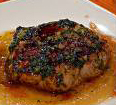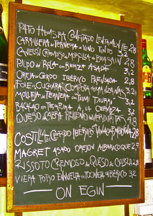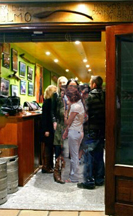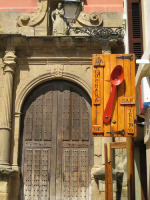Pintxos at the Spoon
 Saturday, April 18, 2009 at 01:17PM
Saturday, April 18, 2009 at 01:17PM The 'Spoon' was overflowing into the square. The first bite of pintxo here made my eyebrows skyrocket in astonishment. The intensity and complexity of flavor in something normally meant as a bar snack was unprecedented. In the 'Spoon', we might have stumbled across the best pintxos in the world. 
Tapas are Spain's ubiquitous bar food, found everywhere with regional variations. In Basque Spain and here in San Sebastian they are called pintxos--the word said to derive from the verb pinchar—to prick—because they were at one time all served with toothpicks. Many still are, and counting toothpicks is often a way for the barman to tally your bill.  But these amazing pintxos are all toothpickless, and rather than being arrayed across the bar on a sea of platters as at the usual pintxos bar, are individually ordered from a chalkboard menu. This temple of pintxo gastronomy is La Cuchara de San Telmo (cuchara means spoon), a narrow space tucked into the corner of a building across from the San Telmo convent under the looming brow of Mt. Urgull, and two blocks from the sea, at the edge of San Sebastian's parte vieja, or old quarter. A long bar takes up one side of the space; a narrow shelf, bar height and just wide enough for a small plate runs along the other. The width between is no more than two people deep, though it frequently seems to contain more. The open miniscule kitchen is at the back. Two barmen take orders and dispense plates, two bar girls pour drinks and ferry plates from the kitchen. Our barman, called Marc, is tall, dark and handsome and speaks better English than our pidgeon Spanish. His is a constant-motion dance--scribble order, pour a glass of txacoli, yell "Alex, un foie, uno; dos canelon, dos!" to chef Alex Montiel at the back, and deliver tiny plates of incredible, beautiful food up and down the bar.
But these amazing pintxos are all toothpickless, and rather than being arrayed across the bar on a sea of platters as at the usual pintxos bar, are individually ordered from a chalkboard menu. This temple of pintxo gastronomy is La Cuchara de San Telmo (cuchara means spoon), a narrow space tucked into the corner of a building across from the San Telmo convent under the looming brow of Mt. Urgull, and two blocks from the sea, at the edge of San Sebastian's parte vieja, or old quarter. A long bar takes up one side of the space; a narrow shelf, bar height and just wide enough for a small plate runs along the other. The width between is no more than two people deep, though it frequently seems to contain more. The open miniscule kitchen is at the back. Two barmen take orders and dispense plates, two bar girls pour drinks and ferry plates from the kitchen. Our barman, called Marc, is tall, dark and handsome and speaks better English than our pidgeon Spanish. His is a constant-motion dance--scribble order, pour a glass of txacoli, yell "Alex, un foie, uno; dos canelon, dos!" to chef Alex Montiel at the back, and deliver tiny plates of incredible, beautiful food up and down the bar.
Beverages to accompany pintxos are usually beer—a half-glass called a cana, a tiny beer known as a zurito, or a txikito of wine—often the local dry, slightly effervescent white called txacoli, sort of like something between cava and a Portugese vinho verde. Txacoli is poured ceremonially from the narrow bottles in a thin stream from arm's length above the squat glass, to increase its natural fizziness.
That first amazing bite was a croqueta de los cocidos y asados—literally "stews and roasts". It's a crispy fried wrapper around a deeply flavored melange of meats and sausage—far from the usual studge of thick bechamel dotted with ham and cheese and deep fried that is a croqueta.
The chefs at La Cuchara have spent time at the molecular gastronomic temple El Bulli, and that influence shows in the elegant dishes. Iñaki Gulin, one of the chef-owners says "young chefs who dream of big restaurants sometimes end up opening bars." At Cuchara Gulin and Alex Montiel, a Basque and a Catalan, have turned that truism into gold with 3-star degustation food at bar prices. Our second pintxo was mollejas en "tximi-txurri" a browned morcel of veal sweetbread in a spicy green sauce--crisp outside and melting inside. Then the canelon of thin pasta was stuffed with cremosa de morcilla de Beasin--said to be the best blood sausage in Spain--and drizzled with a bit of green basil oil.
The fiercely proud denizens of Donostia (the Basque name for San Sebastian) claim that pintxos were invented here in the 15th century, well before anywhere else in Spain. The txikiteo is the term for a 'pintxos crawl' from bar-to-bar. It was in the first decades of the 20th century that cuadrillas, or squadrons, of revellers started these bar crawls. San Sebastián has a tradition of txokos, or gastronomic societies, going back to the early 1800's, in which men would gather in private clubs to prepare traditional dishes, sing and drink--and over 100 of these still exist today. These revelries often spilled into the streets, and resulted in 'flying squadrons' of txikiteros going from place to place. Today, it's not unusual for a half dozen to a dozen people to visit five or six places serially over the course of several hours. La Cuchara is wildly popular, and crowded most of its opening hours, but the crowd seems to come and go in waves. It's occasionally slightly calm, but usually packed to the gills, with enthusiastic snackers spilling into the square, and inching in and out to collect drinks, and plates handed over the heads of patrons at the bar.
La Cuchara is wildly popular, and crowded most of its opening hours, but the crowd seems to come and go in waves. It's occasionally slightly calm, but usually packed to the gills, with enthusiastic snackers spilling into the square, and inching in and out to collect drinks, and plates handed over the heads of patrons at the bar.
Marc next suggested the carillera de ternera—which turned out to be a falling-apart nodule of beef cheek, long slow cooked in a red wine sauce, and served on a scoop of potato puree worthy of Joel Robuchon—simply exquisite. The foie al Cuchara con compote de manazana is a perfectly crisped slice of duck foie gras topped with crystals of sea salt and paired with apple marmalade. To finish we ordered a last pintxo of queso de cabra relleno con verduritas, which brings a silken goat cheese wrapped around a pepper/onion/eggplant confit, topped with a glazed shard of pastry drizzled with balsamic glaze.
The chalkboard also offers tiny shot-glasses of luxurious chilled crab soup dabbed with tomato marmalade, a tempura de bacalau—salt cod in a crunchy beer batter, and a stupendous dish of balsamic-glazed pork ribs, slow-cooked, deboned, molded, then flash-grilled in a process that takes two days--but we're going to have to save those for an absolutely required return visit.
Pintxos are priced 2-4 euros each, roughly double those in a normal pintxos bar, but the portions are somewhat larger, and the quality of food is stratospheric in comparison. One can have a stand up tasting menu equivalent in quality and ingenuity to those three-star temples for 30 euros total, drinks included.
We had set out to perform our own multi-bar txikiteo, but after the astonishing degustation at the Spoon, we would have to put that off for another time--we'd hit the best first, it would stand alone this round, and the thought of dinner near midnight afterward--well fogeddabou . . . .
Reader Comments